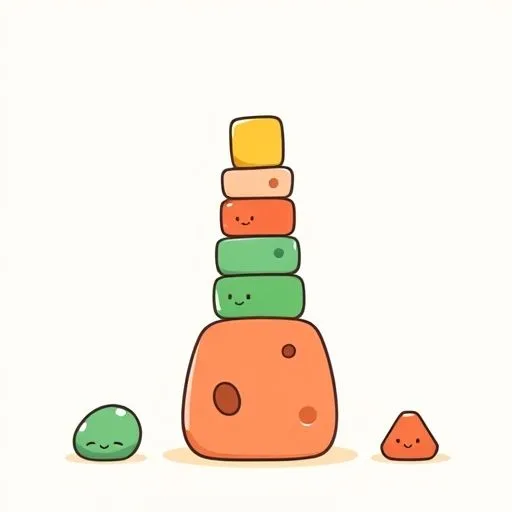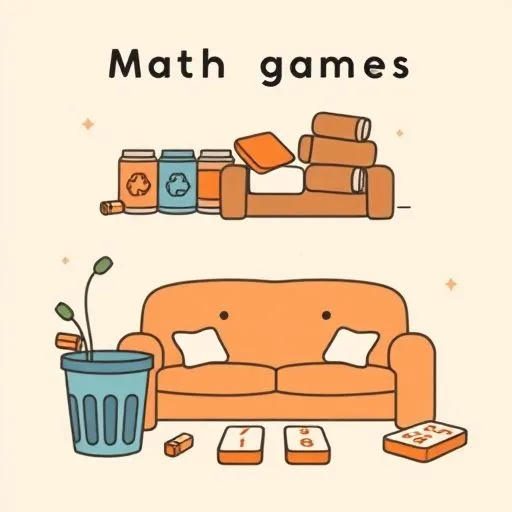
You’ve seen that scene—the one where she’s half- watching her phone screen, half-listening to the kids’ playtime chaos. The way she pauses, her thumb hovering over another parenting group notification about “must-have math apps” before sighing and setting it facedown. I’ve noticed that too. But later, when we were cleaning up after dinner, I saw something else: our daughter lining up carrot sticks in careful rows of three, saying “This one’s your team, Mommy!” with a grin. And that’s when it clicked—those math lessons we’re always chasing? They’re right here in the living room, just waiting to be noticed.
The Hidden Math Lessons All Around Us

Think about the last time you cooked together. When she handed the child the measuring cup and asked, “How many more do we need to fill it up?”—that’s math. Those moments where towers of blocks crash down, and she asks, “How many more can we stack before the whole thing falls?”—that’s problem-solving. It’s not just about numbers. It’s how they’re learning to see patterns in the world, like sorting socks from the basket, or how circles are in the cookies on the plate, and the stars in the storybook.
You’ve seen it: that little shopping trip where the child is sorting coins and declaring, “We need to put the teeny numbers together!” It’s tempting to see it as a sweet distraction. But what if that’s exactly where the learning happens—sitting in the cart, legs swinging, counting the oranges as they roll into the bag? That engagement? It’s not about drills or apps, but about how they naturally interact with the world around them—this is where the mind gets hooked.
Why Play Teaches What Worksheets Can’t

Research shows that play builds mathematical thinking—the deep kind of learning that comes when kids are touching, sorting, and asking “why.” The way we build towers, then knock them down: “How tall can we make it before gravity wins?” It’s not about the right answer; it’s the trial and error with a smile. That’s the power of play. It’s not about being correct. It’s about experimenting, and in that process, they’re discovering the rules of the world—the same way scientists do.
Ultimately, this isn’t about creating a perfect mathematician. It’s about creating a problem-solver, a curious thinker, someone who sees the world as a series of questions—not just calculations.
I remember the day she was looking for the “perfectly shaped” rock to make her tower of stones balance. “This one is a triangle, Daddy!” she said. She didn’t know that we were talking about geometry. She just saw shapes. But in that moment, she was categorizing the world—the natural math of pattern recognition. That’s how play builds numeracy—not through rote memorization, but through hands-on experience and the joy of discovery.
Learning Together: The Parent-Child Magic
Here’s the secret: you’re their best teacher—not because you know all the answers, but because you’re there to explore with them. When you’re cooking together, measuring ingredients becomes a game of fractions. Sorting laundry, matching socks by pairs—this becomes a lesson in sets and comparisons. The conversations we have—the “why do you think…” and “what if we tried…”—are creating the mental pathways that will make math concepts click later.
One of my favorite things to do? Ask the kids to “help me cook” by measuring with their eyes. “How much flour do you think we need?” you’ll ask. “Three scoops!” she’ll say. “Let’s try it—what happens if we use less than that?” It doesn’t always have to be precise. Baking together, we’ve made some pretty, uh, creative pancakes, but the laughter and the learning stayed with us long after the dishes were done.
The Game That’s Always Hiding in the Clutter

Here’s my challenge: look for the math hidden in today’s clutter. Let the kids sort the recycling—counting cans, arranging them into rows. “Which group has more?” Let them build a fort with the couch cushions—”How tall can we stack it before it falls over?” Watch how they negotiate with the cookie jar—”If I eat half of mine now, can I share the rest with you?” That’s fractions in action.
Card games are another great example of simple play that builds math skills. Uno, Go Fish, even simple games where you’re matching numbers—these are teaching the concept of “more than” and “less than,” without ever feeling like a lesson. Even something as simple as a board game—moving pieces around the board, counting spaces—is building the foundation for arithmetic.
The Heart of It All: Building a Love for Math

The way we play teaches them to approach math with confidence, not dread. The laughter, the mess, and the “oh well, let’s try again”—these are the moments that will make math a friend, not a foe.
When you see kids lining up toys, or counting raisins in the cereal, it’s more than just a moment. It’s the first spark of understanding. And that? That’s a love of learning that grows best with a high five, and a “We’re in this together!”
That’s the kind of math that will stick with them—not just through school, but through life. And that’s the kind of learning that starts with play, not pressure.
Source: Amazon seeks more grassroots adoption of its AI products, relying less on salespeople, Business Insider, 2025-09-29
